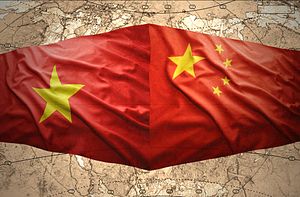Vietnam’s Foreign Ministry announced Monday that Politburo member Le Hong Anh will visit China from August 26 to 27 as a special envoy of Nguyen Phu Trong, the secretary general of the Communist Party of Vietnam (CPV). A Foreign Ministry spokesperson told reporters that Anh would meet with Chinese leaders to discuss “measures to ease the situation, prevent the recurrence of recent tenses [sic], and enhance the relationship between the two Parties and two countries.” Anh was invited to visit China by the Central Committee of the Chinese Communist Party (CCP).
Ties between Vietnam and China have been strained since May, when China deployed an oil rig near the Paracel Islands in waters Hanoi claims as part of its exclusive economic zone. Over the next few months, the waters around the oil rig became the scene of numerous confrontations and collisions between Chinese and Vietnamese vessels. Meanwhile, anti-China sentiment in Vietnam boiled over into full-scale riots, damaging dozens of foreign factories (many of which were owned by Taiwanese or South Korean companies) in southern regions.
Anh’s visit to China will only be the second high-profile bilateral visit since the oil rig crisis — and the last one, State Councilor Yang Jiechi’s trip to Hanoi, didn’t go so well. Yang visited Vietnam in mid-June for meetings with leaders, including Prime Minister Nguyen Tan Dung and Deputy Prime Minister and Foreign Minister Pham Binh Minh. However, rather than thawing the relationship, Yang’s trip merely saw both sides dig in on their existing positions. Yang reiterated China’s commitment to protecting the oil rig and demanded that Vietnam stop its “harassment” of the vessel. Vietnamese officials, meanwhile, repeated their complaint that the oil rig was operating in violation of Vietnamese sovereignty and should be removed immediately.
It may be easier for both sides to talk now that the immediate crisis is over. China’s oil rig left the area in July, a month earlier than originally scheduled. In addition, the decision to frame this current outreach as a CCP-CPV exchange rather than a full-scale political meeting could be useful. The communist parties of China and Vietnam have historically worked closely together. Plus, though both parties effectively are the governments of their respective countries, there is just enough of a line between party and state to allow for some wiggle room. Both sides will be carrying out their dialogue primarily as party members, not as statesmen — making it easier to sell a friendly atmosphere back home.
Vietnam has already attempted to provide some positive momentum by addressing the fallout from May’s anti-China riots. A Foreign Ministry spokesperson promised that Hanoi would provide “humanitarian assistance” to Chinese workers affected by the riots. In response, Chinese Foreign Ministry spokesperson Hong Lei said that “China acknowledges the steps and positions the Vietnamese side has taken, and hope[s] earnest efforts can be taken to implement relevant measures.” After the riots, China evacuated 3,500 of its workers away from Vietnam. Since then, the Wall Street Journal reports, around 2,000 have returned.
Though Vietnam is seeking to repair its strained relationship with China, the government is still actively trying to diversify its diplomatic and economic relations. Doing so will allow Hanoi to hedge against overreliance on China should another crisis emerge in the future. Vietnam’s most high-profile potential partner is the United States. Reuters notes that four U.S. senators have gone to Vietnam since May, evidence of a growing movement in Congress to lift the U.S. embargo on selling lethal weapons to Vietnam. The potential for increasing defense cooperation between Hanoi and Washington has sparked speculation about the possibility of an informal alliance between the two.
Vietnam is also seeking closer to ties India. Even as Anh heads to China, Indian Foreign Minister Sushma Swaraj is in Vietnam for a three day visit. Indian President Pranab Mukherjee is expected to follow in mid-September, around the same time that Chinese President Xi Jinping is expected to visit India. Vietnam has made it clear that it believes India has a role to play in balancing against China’s increasing regional influence.
In an interview with the India Writes Network, Vietnam’s ambassador to India, Nguyen Thanh Tan, emphasized Vietnam and India’s similar positions on regional issues. “We need Indian balance in the region… We also see [an] Indian role in ARF,” Tan said, referring to the ASEAN Regional Forum. Tan also noted growing economic and defense ties between Hanoi and New Delhi. Most intriguingly, India has leased exploration rights to seven oil and gas blocks in the South China Sea from Vietnam, despite China’s extensive maritime claims in the region.
Still, despite growing ties with other countries like the U.S. and India, Hanoi needs to maintain a cordial relationship with China, especially in the economic realm. Vietnam and China’s bilateral trade is worth $50 billion; Vietnam-U.S. trade only amounts to $28.7 billion. Vietnam-India trade is even smaller, valued at around $6 billion in 2013. Even Ambassador Tan’s optimistic estimate for 2020 puts total Vietnam-India trade at $15 billion.
For Vietnam then, despite its hedging strategy, Le Hong Anh’s visit to China has important implications. And for China, getting its relationship with Hanoi back on track will provide a needed boost to China’s regional image. Now that the crisis is over, both sides can be more cordial — at least until the next territorial dispute begins.
































